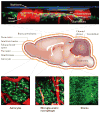Illuminating viral infections in the nervous system
- PMID: 21508982
- PMCID: PMC5001841
- DOI: 10.1038/nri2971
Illuminating viral infections in the nervous system
Abstract
Viral infections are a major cause of human disease. Although most viruses replicate in peripheral tissues, some have developed unique strategies to move into the nervous system, where they establish acute or persistent infections. Viral infections in the central nervous system (CNS) can alter homeostasis, induce neurological dysfunction and result in serious, potentially life-threatening inflammatory diseases. This Review focuses on the strategies used by neurotropic viruses to cross the barrier systems of the CNS and on how the immune system detects and responds to viral infections in the CNS. A special emphasis is placed on immune surveillance of persistent and latent viral infections and on recent insights gained from imaging both protective and pathogenic antiviral immune responses.
Conflict of interest statement
statement The authors declare no competing financial interests.
Figures




References
-
- Nimmerjahn A, Kirchhoff F, Helmchen F. Resting microglial cells are highly dynamic surveillants of brain parenchyma in vivo. Science. 2005;308:1314–1318. This study used TPLSM to show that microglial processes are highly dynamic and continually scan the naive brain parenchyma. - PubMed
-
- Bulloch K, et al. CD11c/EYFP transgene illuminates a discrete network of dendritic cells within the embryonic, neonatal, adult, and injured mouse brain. J Compar Neurol. 2008;508:687–710. - PubMed
-
- Chinnery HR, Ruitenberg MJ, McMenamin PG. Novel characterization of monocyte-derived cell populations in the meninges and choroid plexus and their rates of replenishment in bone marrow chimeric mice. J Neuropathol Exp Neurol. 2010;69:896–909. - PubMed
Publication types
MeSH terms
Grants and funding
LinkOut - more resources
Full Text Sources

